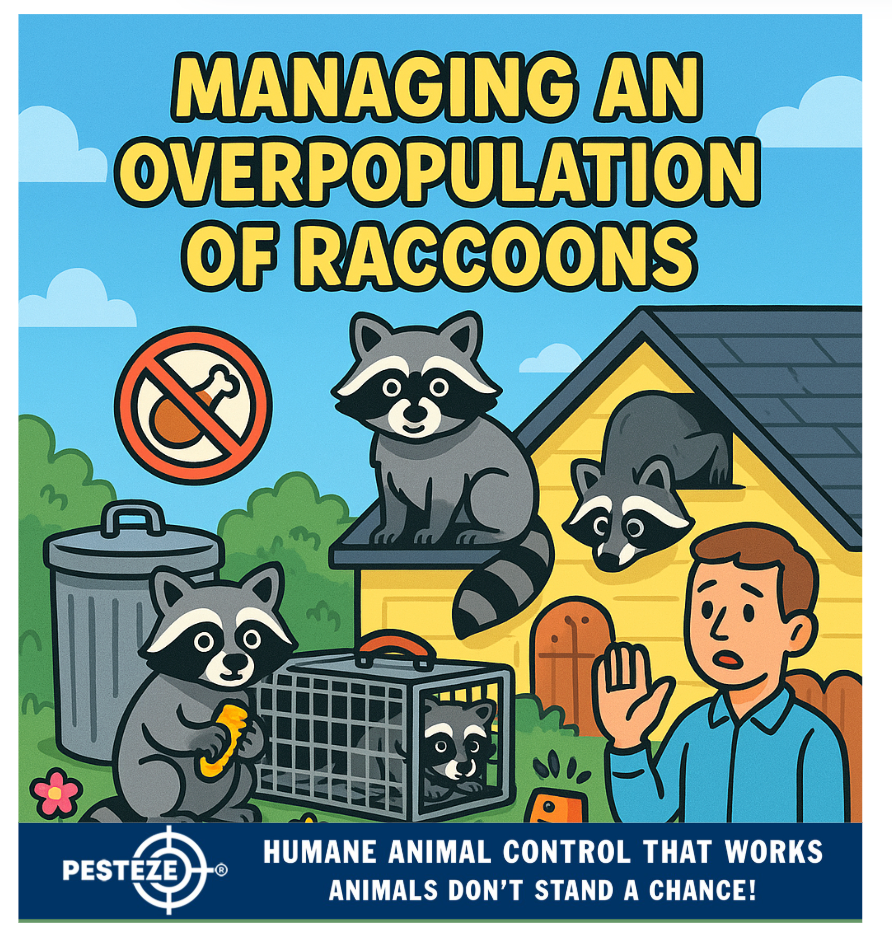MANAGING AN OVERPOPULATION OF RACCOONS

MANAGING AN OVERPOPULATION OF RACCOONS
SUMMARY
This guide explains how to handle raccoon overpopulation in a humane and effective way. It covers prevention, safe removal, and long-term management strategies to reduce property damage, disease risks, and nuisance behavior without harming wildlife.
FEATURES
-
Identify Attractants: Locate and eliminate food and shelter sources.
-
Secure Trash and Food: Prevent raccoons from scavenging household waste.
-
Use Humane Deterrents: Apply light, sound, and scent-based repellents.
-
Install Barriers: Protect attics, chimneys, and crawl spaces from entry.
-
Trap and Relocate Responsibly: Follow local regulations for humane removal.
-
Promote Community Cooperation: Encourage neighbors to adopt prevention habits.
GUIDE DESCRIPTION
Raccoons are intelligent, adaptable animals that thrive in both rural and urban environments. When their populations grow unchecked, they can cause significant issues for homeowners and communities alike. From rummaging through trash and damaging roofs to spreading diseases like rabies and leptospirosis, raccoon overpopulation poses both practical and public health concerns. Addressing the problem humanely ensures the safety of both people and wildlife.
The first step in managing an overpopulation of raccoons is prevention. Raccoons are opportunistic feeders, meaning they go where food is easy to find. Keep garbage cans tightly sealed with locking lids, avoid leaving pet food outside, and regularly clean up fallen fruit or birdseed. Compost bins should be raccoon-proof, and gardens can be protected with motion-activated sprinklers. By cutting off easy food sources, you make your property far less appealing.
Next, eliminate shelter options. Raccoons often nest in attics, sheds, chimneys, or under decks. Inspect your property for signs of entry such as claw marks, droppings, or loose vents. Seal potential access points with sturdy materials like galvanized mesh or metal flashing. Chimney caps and vent covers can be installed to further discourage nesting. Always check for young raccoons before sealing entryways to avoid trapping animals inside.
For existing populations, humane deterrents can help encourage relocation. Ultrasonic noise devices, bright lights, or ammonia-soaked rags placed near dens can drive raccoons away naturally. If these measures fail, humane traps may be used, but local wildlife regulations must be followed. In many areas, it’s illegal to relocate raccoons without permission from animal control due to disease transmission risks. Instead, licensed professionals can handle removal and ensure compliance with laws.
Finally, long-term success depends on collective effort. A single household’s prevention measures won’t last if neighbors continue to provide easy access to food or shelter. Educating the community, sharing best practices, and maintaining consistent property inspections can help stabilize raccoon populations.
By combining prevention, humane deterrence, and community cooperation, raccoon overpopulation can be managed effectively and ethically. Responsible actions today create a safer, cleaner environment for both people and wildlife.
- Saneeth Thota


Comments 0